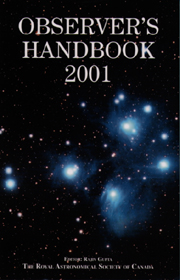
The Royal Astronomical Society of Canada "OBSERVERS HANDBOOK 2001"
 Above: RASC "Observers Handbook 2001". Cover photograph of the Pleiades star cluster, one of the most popular astronomical objects. Three separate exposures were taken using a Pentax 6x7 cm format; two on black and white film and one on color, all of which were then digitally combined. Photo taken by the Editor, Rajiv Gupta using Astro-Physics 130mm f6 EDF Apochromat refracting telescope. |
The "Observers Handbook" is one of Canada's oldest scientific publications. This is the 288 page annual guide that is most highly recommended by Company Seven for the novice, or for the experienced observer. This is a very readable, annual publication where the next edition becomes available in late October of each prior year for sale at Company Seven's Laurel, MD showroom; we will also deliver this by mail order to around the world.
This book helps one to plan an observing or astrophotography session well in advance of the date of the event. This book is a valuable resource with tables, formulae, and numerous articles of advice about astronomical objects, optics, human vision. In one simple to use reference you can find out: how many moons does Jupiter have? (and read information about each). How big is the Sun? When will an object be in a good part of the sky to view or image? How to observe? And much more.
Published annually since 1907 when it first appeared as The Canadian Astronomical Handbook for 1907", it was created by C.A. Chant (b. 1865, d. 1956), Professor of Astronomy at the University of Toronto. His vision was of "a companion which the observer would wish to have in his pocket or on the table before him". It has been published as "Observers Handbook" since 1911, this has grown to be the most comprehensive yet lightweight and compact publication of it's type with Chant remaining as the Editor until the 1957 edition. The present (and 5th) Editor is Rajiv Gupta who takes the helm into the new millenium from Dr. Roy L. Bishop.
Considering it's content, while remaining only 5-1/2 inch wide, 8-1/2 inch tall, and 1/2 inch thick, this is a remarkably handy and easy to travel with publication. With contributing authors of the various sections being experts in their respective field. The "Observer's Guide" includes includes discussions and drawings of periodic astronomical events that are known to be coming in that year, as well as good coverage of topics and astronomical data including:
- Introductory Section:
- List of Contributors, Preface, Editors Comments, How to Use the Book, Reporting of Astronomical Discoveries, Cover Photograph Caption, Information about the RASC, Visiting Hours at Some Canadian Observatories and Planetaria, Suggestions for Further Reading, Suggested Atlases, Teaching and the Observers Handbook, Symbols (Sun, Moon, & Planets, Zodiac Signs; Greek Alphabet), Coordinate Systems, and Terminology.
- Basic Data:
- Principal Elements of the Solar System (Mean Orbital and Physical), Satellites of the Solar System, Satellites of the Asteroids, Some Astronomical and Physical Data, Voyages in our Planetary System, Precession Table.
- Time:
- General Introduction, Introduction to the Time Zone Map, Time Zone Map, Time Signals, Mean Sidereal Time, Julian Date, Standard Time Zones, Astronomical Twilight and Siderial Time.
- Optics & Observing:
- Telescope Parameters: Equations and Performance, Telescope Exit Pupils, Binoculars, Filters, Sky Transparency, Frequency of Clear Nights, Light Pollution.
- The Sky Month by Month:
- Introduction, Holidays and Special Dates, Positions and Distances and Magnitudes of the Major Planets Through the Month, Descriptions of the Moon and Major Planets - Where to Find Them and How They Will Appear, A Day to Day Chronology of Astronomical Events (meteor showers, algol, new moon, first quarter moon, full moon, last quarter moon, double transits on Jupiter, oppositions, conjunctions, eclipses, etc.), and Configurations (Appearance/Orientation) of the Four Major Moons of Jupiter.
- Sun:
- Ephemeris, Sundial Correction, Orientation of the Sun, Solar Activity, Auroral Forms, Times of Sunset and Sunrise, Twilight Table, Midnight Twilight and Midnight Sun.
- Moon:
- Key to the Map of the Moon, Map of the Moon, Universal Time of New Moon Dates, Times of Moonrise and Moonset, Eclipses, Eclipse Patterns, Viewing a Solar Eclipse - A Warning, Occultations by the Moon (Total and Grazing), Tides and the Earth-Moon system.
- Planets and Satellites:
- General Introduction, Planetary Heliocentric Longitudes, Magnitudes of the Naked Eye Planets during the Year, Pronunciation of Planet Names, Diagram of Planetary Configurations
Telescopic appearance of the planets, Pronunciation of Satellite Names, Solar System Geometry, Telescopic Appearance of the Planets, Planetary Right Ascension chart, The Planets for The Year an Introduction, Mercury, Venus, Mars, Jupiter, Saturn, Uranus, Neptune, Pluto, Finder chart for Uranus and Neptune, Finder chart for Pluto, Phenomena of Jupiter's Galilean Satellites, Configurations of Saturn's Brightest Satellites.
- Asteroids:
- Ephemerides for the Brightest Asteroids, Planetary Appulses and Occultations.
- Meteors, Comets, and Dust:
- Meteors, Fireballs, Radio Detection of Meteors, Meteorite Identification, Meteorite, Impact Craters of North America, Comets, Observing Comets, Interplanetary Dust.
- Stars:
- Constellations, Finding List of Some Named Stars, The Brightest Stars, The Nearest Stars, Double and Multiple Stars, Variable Stars, Star Clusters, Amateur Supernova Hunting, Expired Stars.
- Nebulae:
- Galactic Nebulae, The Messier Catalogue, Deep-Sky Observing Hints, The Finest NGC Objects, Deep-Sky Challenge Objects, Galaxies: Brightest and Nearest, The NASA/IPAC Extragalactic Database (NED), Galaxies with Proper Names, Radio Sources, Variable Galaxies.
- Maps of the Night Sky:
- Description of maps, January, March, May, July, September, November, The Southern Sky
- Concluding Section:
- Order form for the next year's Observer's Handbook, Key to Left-Hand Margin Symbols, Index, Some Holidays and Special Dates for the Year, 2001 and 2002 Calendars (with New Moon dates), Selected Index of Internet Web Addresses.
Price $23.00 (U.S.D.); please add $4.00 for domestic postage, or $12.00 for international postage.
Contents Copyright 1994-2000 Company Seven All Rights Reserved

